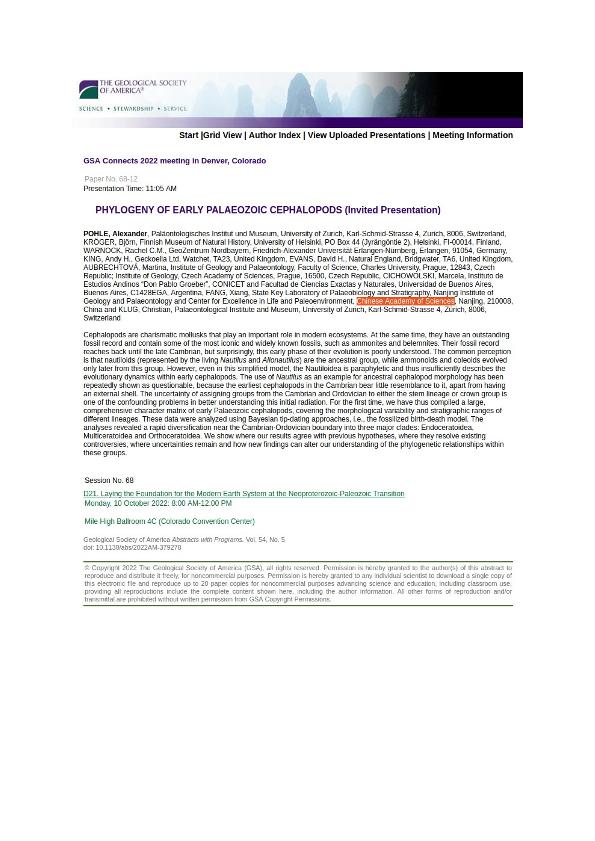Mostrar el registro sencillo del ítem
dc.contributor.author
Pohle, Alexander
dc.contributor.author
Kröger, Björn
dc.contributor.author
Warnock, Rachel
dc.contributor.author
King, Andy H.
dc.contributor.author
Vans, David H.,
dc.contributor.author
Aubrechtová, Martina
dc.contributor.author
Cichowolski, Marcela

dc.contributor.author
Fang, Xiang
dc.contributor.author
Klug, Christian
dc.date.available
2024-02-22T10:04:32Z
dc.date.issued
2022
dc.identifier.citation
Phylogeny of early Palaeozoic cephalopods; The Geological Society of America Annual Meeting; Denver; Estados Unidos; 2022; 1-1
dc.identifier.uri
http://hdl.handle.net/11336/227925
dc.description.abstract
Cephalopods are charismatic mollusks that play an important role in modern ecosystems. At the same time, they have an outstanding fossil record and contain some of the most iconic and widely known fossils, such as ammonites and belemnites. Their fossil record reaches back until the late Cambrian, but surprisingly, this early phase of their evolution is poorly understood. The common perception is that nautiloids (represented by the living Nautilus and Allonautilus) are the ancestral group, while ammonoids and coleoids evolved only later from this group. However, even in this simplified model, the Nautiloidea is paraphyletic and thus insufficiently describes the evolutionary dynamics within early cephalopods. The use of Nautilus as an example for ancestral cephalopod morphology has been repeatedly shown as questionable, because the earliest cephalopods in the Cambrian bear little resemblance to it, apart from having an external shell. The uncertainty of assigning groups from the Cambrian and Ordovician to either the stem lineage or crown group is one of the confounding problems in better understanding this initial radiation. For the first time, we have thus compiled a large, comprehensive character matrix of early Palaeozoic cephalopods, covering the morphological variability and stratigraphic ranges of different lineages. These data were analyzed using Bayesian tip-dating approaches, i.e., the fossilized birth-death model. The analyses revealed a rapid diversification near the Cambrian-Ordovician boundary into three major clades: Endoceratoidea, Multiceratoidea and Orthoceratoidea. We show where our results agree with previous hypotheses, where they resolve existing controversies, where uncertainties remain and how new findings can alter our understanding of the phylogenetic relationships within these groups.
dc.format
application/pdf
dc.language.iso
eng
dc.publisher
Geological Society of America

dc.rights
info:eu-repo/semantics/openAccess
dc.rights.uri
https://creativecommons.org/licenses/by-nc-sa/2.5/ar/
dc.subject
BAYESIAN ANALYSIS
dc.subject
EARLY CEPHALOPODS
dc.subject
PHYLOGENY
dc.subject
CLASSIFICATION
dc.subject.classification
Paleontología

dc.subject.classification
Ciencias de la Tierra y relacionadas con el Medio Ambiente

dc.subject.classification
CIENCIAS NATURALES Y EXACTAS

dc.title
Phylogeny of early Palaeozoic cephalopods
dc.type
info:eu-repo/semantics/publishedVersion
dc.type
info:eu-repo/semantics/conferenceObject
dc.type
info:ar-repo/semantics/documento de conferencia
dc.date.updated
2024-01-08T13:15:57Z
dc.journal.volume
54
dc.journal.number
5
dc.journal.pagination
1-1
dc.journal.pais
Estados Unidos

dc.journal.ciudad
Denver
dc.description.fil
Fil: Pohle, Alexander. Universitat Zurich; Suiza
dc.description.fil
Fil: Kröger, Björn. University of Helsinki; Finlandia
dc.description.fil
Fil: Warnock, Rachel. Universitat Erlangen Nuremberg; Alemania
dc.description.fil
Fil: King, Andy H.. No especifíca;
dc.description.fil
Fil: Vans, David H.,. No especifíca;
dc.description.fil
Fil: Aubrechtová, Martina. No especifíca;
dc.description.fil
Fil: Cichowolski, Marcela. Consejo Nacional de Investigaciones Científicas y Técnicas. Oficina de Coordinación Administrativa Ciudad Universitaria. Instituto de Estudios Andinos "Don Pablo Groeber". Universidad de Buenos Aires. Facultad de Ciencias Exactas y Naturales. Instituto de Estudios Andinos "Don Pablo Groeber"; Argentina
dc.description.fil
Fil: Fang, Xiang. Chinese Academy of Sciences; República de China
dc.description.fil
Fil: Klug, Christian. Universitat Zurich. Instituto Palaontologisches Institut And Museum; Suiza
dc.relation.alternativeid
info:eu-repo/semantics/altIdentifier/url/https://gsa.confex.com/gsa/2022AM/webprogram/Paper379278.html
dc.relation.alternativeid
info:eu-repo/semantics/altIdentifier/doi/http://dx.doi.org/10.1130/abs/2022AM-379278
dc.conicet.rol
Autor

dc.conicet.rol
Autor

dc.conicet.rol
Autor

dc.conicet.rol
Autor

dc.conicet.rol
Autor

dc.conicet.rol
Autor

dc.conicet.rol
Autor

dc.conicet.rol
Autor

dc.conicet.rol
Autor

dc.coverage
Internacional
dc.type.subtype
Reunión
dc.description.nombreEvento
The Geological Society of America Annual Meeting
dc.date.evento
2022-10-09
dc.description.ciudadEvento
Denver
dc.description.paisEvento
Estados Unidos

dc.type.publicacion
Book
dc.description.institucionOrganizadora
The Geological Society of America
dc.source.libro
Abstracts of the Geological Society of America Annual Meeting
dc.date.eventoHasta
2022-10-12
dc.type
Reunión
Archivos asociados
